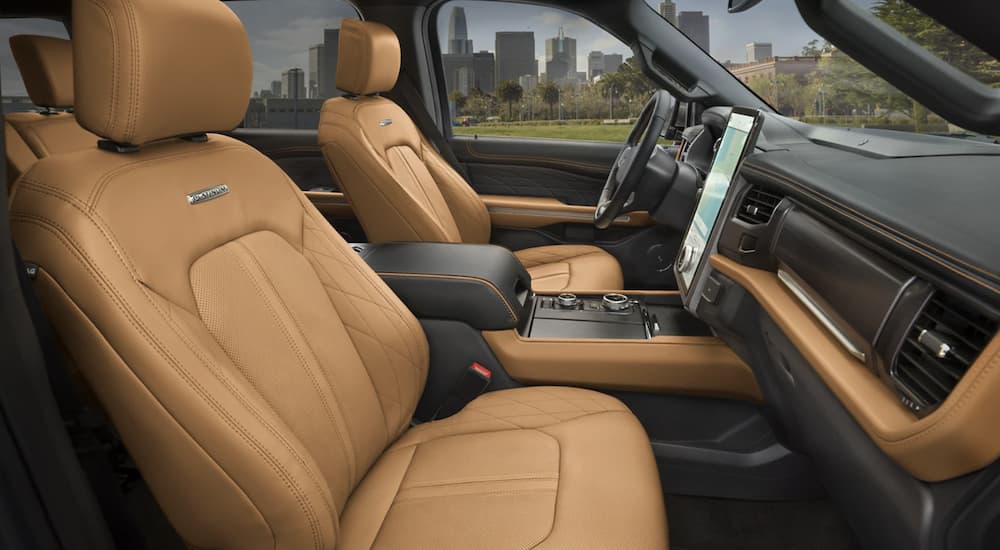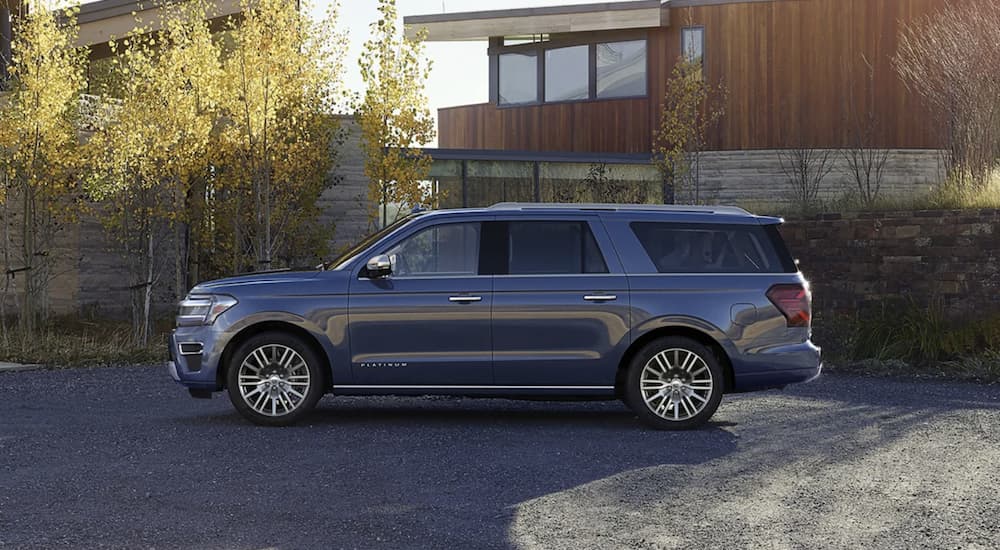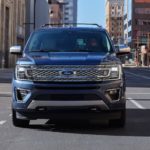Towards the end of the 1800s, automotive technology was taking off. Maybe crawling off is better phrasing—these things were not fast. Even so, the first accident happened long before cars became a part of everyday life. An inventor from Ohio, John William Lambert, purchased a three-cylinder engine and tinkered with it until it was a single-cylinder engine capable of powering a part-buggy, part-wheelbarrow chassis up to five mph, making his invention fast enough to be almost dangerous. Eventually, he drove his car over a tree root and subsequently crashed it into a hitching post. There were no serious injuries, thanks in part to the sheer slowness of these early vehicles. The potential hazard was there, though, and the increasing velocity of our cars necessitated the development of safety precautions.
Fast forward to today and the 2023 Ford Expedition. It’s a full-size SUV that gets 400 hp from its turbocharged V6 for a maximum speed that’s much higher than five mph. It’s a beast, but it’s also safe. This is partially due to the heft of an SUV. Larger, heavier vehicles tend to be safer in the event of front-end or rear-end collisions because they provide more crumple room between their occupants and the other vehicle(s). Also, because they’re heavier, they will move more (as opposed to stopping on a dime) when involved in accidents with lighter vehicles, so passengers get less of a whiplash effect.
Of course, you hope that car accidents never happen. To that end, modern automakers have invested heavily in making their cars drive smarter and safer. The newest vehicles may come equipped with a whole suite of automated safety features, but once upon a time, they didn’t even have seat belts. The Expedition is a great example of how far vehicle safety has come, as a 2023 model is more than a hair safer than the flagship Expedition.
The First Generation Expedition: Kind of Safe
The very first Expedition debuted in the late ’90s, so it completely avoided the most hazardous years of driving. You’ve probably heard someone lamenting over the cheapness of new cars, how they’re made of plastic and buckle at the slightest touch. Well, it turns out the high-strength, ultra-rigid car bodies of yesteryears are extremely unsafe for the fragile, flesh-and-bone bodies that inhabit them. A little give can be a good thing.
So, the first generation Expedition had a proper crumple zone. It also benefitted from a wave of safety features adopted by automakers in the late ’60s due to Congress approving a bill that allowed the federal government to set safety standards for new cars. Things like seatbelts, airbags, and padded dashboards were the norm as the 20th century drew to a close. On top of these goodies, the first-generation Expedition had the following features, which were kind of cutting-edge at the time:
Inertia Safety Switch
This is a small device that can fit in the palm of your hand. If it gets a hard enough jostle—say, from a collision—it will trigger or interrupt certain functions. This generation of Expedition had an inertia switch that shut off the fuel pump in the event of a crash, lessening the potential for fires post-accident.
SecuriLock With Engine Immobilizer
This is more of a security feature than a safety feature, but they kind of go hand-in-hand. To combat car theft, automakers started putting transponders in their keys; the first generation Expedition was one of the first examples by Ford to have their SecuriLock technology. Essentially, the key sends out a unique signal upon starting up the car. If the signal isn’t there or is incorrect, an immobilizer prevents the engine from starting.
The Modern Expedition: Setting the Bar for Safety
Fast forward several decades, and you’ve got an Expedition that makes its predecessor feel about as safe as skydiving without a parachute. To get to where we are now, the second and third generations ushered in incremental safety measures too. It used to be expected for automakers to offer upgraded airbag systems at an increased price. Realizing putting a premium on basic safety was in bad taste, this practice was phased out of the Expedition. Increased safety standards dictated by the feds probably gave automakers a healthy nudge in the right direction, too.
AdvanceTrac With Roll Stability Control
A lot of modern safety systems lean on sensors to predict and adapt to different driving conditions. One such example of this is Ford’s AdvanceTrac system, which comes with Roll Stability Control in the 2023 Expedition. It works by monitoring the vehicle’s traction; if it starts to slip, the system will automatically apply selective braking, helping the vehicle to get back on track. Roll Stability Control works similarly, with the goal being to keep all four tires firmly connected to the road.
Heightened Visibility
New cars these days come standard with a backup camera, making reversing into a parking space possible without doing neck gymnastics to make sure you’re properly lined up. Aside from preventing a kinked neck, backup cameras also increase safety by improving the driver’s viewpoint while backing out of parking spaces, say, in a busy parking lot. It’s easier to see cars and pedestrians directly behind your vehicle using the camera view as opposed to quick glances at three different mirrors to try to create a complete picture of the area behind your vehicle.
Towards the top of the Expedition’s trim line, more camera views become standard with the 360-degree camera. It may sound like one sophisticated camera with the peripherals of a housefly, but it’s actually a system that depends on multiple cameras placed around the Expedition’s exterior. It gives the driver the full scope of their surroundings, showing a wider view at the rear than the standard backing camera, a front view (for things that are too low for the driver to see), and an aerial view.
Standard Driving Assistance Features
Since the late ’90s, safety has grown more sophisticated, encompassing collision avoidance as opposed to just mitigating damages when an accident does occur. I am, of course, referring to all of those driving assistance features whose capabilities have far-surpassed a simple cruise control function. Here are a couple of the features that come standard across all trim levels of the 2023 Expedition:
Pre-Collision Assist With Automatic Emergency Braking (AEB)
It’s hard to say how many rear-end accidents are caused by distracted driving, but if I had to venture a guess, the number would be up there. We’re all human, and maintaining perfect focus 100% of the time while driving just isn’t realistic. Fortunately, Pre-Collision Alert with Automatic Emergency Braking is not human and, as long as it’s functioning properly, does have 100% perfect focus. It scans the road ahead at all times, alerting the driver to any potential collisions detected. If necessary, AEB will kick in to help avoid the impact or at least lessen its severity.
Blind Spot Information System (BLIS)
Going in blind is an idiom describing a situation where guesswork is made necessary by a lack of information. The aptly-named blind spot can turn a simple lane change into a guessing game, which is never something we want while driving at high speeds on a highway. Ford’s Blind Spot Information System provides drivers with an extra set of eyes that are specifically trained on the would-be blind spots. BLIS alerts the driver to vehicles they might not be able to see by lighting up icons on the side mirrors.
Safety First and Foremost
Automakers aren’t completely past putting a price tag on safety, and a lot of safety and driver assistance features require paying an additional fee or opting for a pricier trim. Ford does put a premium on driver assistance features that aim to increase convenience, like adaptive cruise control, which is only included on higher-level trims. However, the most important safety features, like the ones mentioned above, are standard in even the base-level 2023 Expedition. Whether it’s mitigating damages post-accident or preventing one from happening in the first place, the newest Expedition from Ford puts safety at the forefront.






